
The pyroxenes are a group of important rock-forming inosilicate minerals found in many igneous and metamorphic rocks. Pyroxenes have the general formula XY(Si,Al)2O6, where X represents calcium (Ca), sodium (Na), iron or magnesium (Mg) and more rarely zinc, manganese or lithium, and Y represents ions of smaller size, such as chromium (Cr), aluminium (Al), magnesium (Mg), cobalt (Co), manganese (Mn), scandium (Sc), titanium (Ti), vanadium (V) or even iron. Although aluminium substitutes extensively for silicon in silicates such as feldspars and amphiboles, the substitution occurs only to a limited extent in most pyroxenes. They share a common structure consisting of single chains of silica tetrahedra. Pyroxenes that crystallize in the monoclinic system are known as clinopyroxenes and those that crystallize in the orthorhombic system are known as orthopyroxenes.
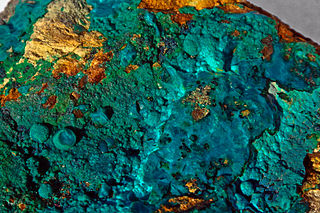
Silicate minerals are rock-forming minerals made up of silicate groups. They are the largest and most important class of minerals and make up approximately 90 percent of Earth's crust.
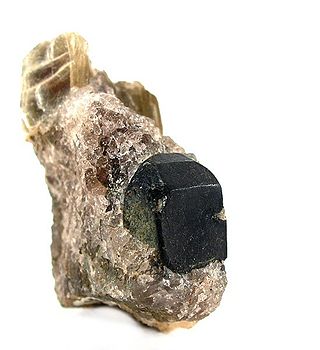
Triphylite is a lithium iron(II) phosphate mineral with the chemical formula LiFePO4. It is a member of the triphylite group and forms a complete solid solution series with the lithium manganese(II) phosphate, lithiophilite. Triphylite crystallizes in the orthorhombic crystal system. It rarely forms prismatic crystals and is more frequently found in hypidiomorphic rock. It is bluish- to greenish-gray in color, but upon alteration becomes brown to black.

Phosphate minerals contain the tetrahedrally coordinated phosphate (PO43−) anion, sometimes with arsenate (AsO43−) and vanadate (VO43−) substitutions, along with chloride (Cl−), fluoride (F−), and hydroxide (OH−) anions, that also fit into the crystal structure.
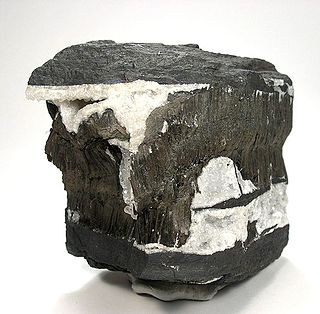
Todorokite is a complex hydrous manganese oxide mineral with generic chemical formula (Na,Ca,K,Ba,Sr)
1-x(Mn,Mg,Al)
6O
12·3-4H
2O. It was named in 1934 for the type locality, the Todoroki mine, Hokkaido, Japan. It belongs to the prismatic class 2/m of the monoclinic crystal system, but the angle β between the a and c axes is close to 90°, making it seem orthorhombic. It is a brown to black mineral which occurs in massive or tuberose forms. It is quite soft with a Mohs hardness of 1.5, and a specific gravity of 3.49 - 3.82. It is a component of deep ocean basin manganese nodules.

Jacobsite is a manganese iron oxide mineral. It is in the spinel group and forms a solid solution series with magnetite. The chemical formula is (Mn,Mg)Fe2O4 or with oxidation states and substitutions: (Mn2+,Fe2+,Mg)(Fe3+,Mn3+)2O4.
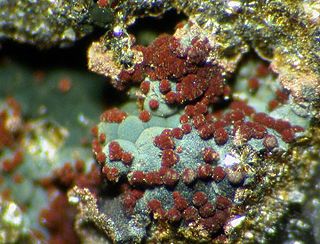
Robertsite, Ca3(Mn3+)4[(OH)3| (PO4)2]2·3(H2O) (alternatively formulated Ca2(Mn3(PO4)3O2)(H2O)3), is a secondary phosphate mineral named for Willard Lincoln Roberts (1923–1987), mineralogist and professor at South Dakota School of Mines in Rapid City, South Dakota.

Layered double hydroxides (LDH) are a class of ionic solids characterized by a layered structure with the generic layer sequence [AcB Z AcB]n, where c represents layers of metal cations, A and B are layers of hydroxide anions, and Z are layers of other anions and neutral molecules. Lateral offsets between the layers may result in longer repeating periods.
Eudialyte group is a group of complex trigonal zircono- and, more rarely, titanosilicate minerals with general formula [N(1)N(2)N(3)N(4)N(5)]3[M(1a)M(1b)]3M(2)3M(4)Z3[Si24O72]O'4X2, where N(1) and N(2) and N(3) and N(5) = Na+ and more rarely H3O+ or H2O, N(4) = Na+, Sr2+, Mn2+ and more rarely H3O+ or H2O or K+ or Ca2+ or REE3+ (rare earth elements), M(1) and M(1b) = Ca2+, M(1a) = Ca2+ or Mn2+ or Fe2+, M(2) = Fe (both II and III), Mn and rarely Na+, K+ or Zr4+, M(3) = Si, Nb and rarely W, Ti and [] (vacancy), M(4) = Si and or rarely [], Z Zr4+ and or rarely Ti4+, and X = OH−, Cl− and more rarely CO32− or F−. Some of the eudialyte-like structures can even be more complex, however, in general, its typical feature is the presence of [Si3O9]6− and [Si9O27]18− ring silicate groups. Space group is usually R3m or R-3m but may be reduced to R3 due to cation ordering. Like other zirconosilicates, the eudialyte group minerals possess alkaline ion-exchange properties, as microporous materials.
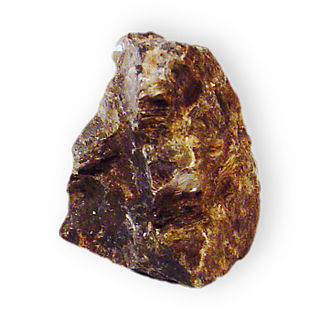
Alluaudite is a relatively common alkaline manganese iron phosphate mineral with the chemical formula (Na,Ca)Mn2+(Fe3+,Mn2+,Fe2+,Mg)2(PO4)3. It occurs as metasomatic replacement in granitic pegmatites and within phosphatic nodules in shales.

Cyrilovite (NaFe33+(PO4)2(OH)4·2(H2O)) is a hydrous sodium iron phosphate mineral. It is isomorphous and isostructural with wardite, the sodium aluminium counterpart.

Hureaulite is a manganese phosphate with the formula Mn2+5(PO3OH)2(PO4)2·4H2O. It was discovered in 1825 and named in 1826 for the type locality, Les Hureaux, Saint-Sylvestre, Haute-Vienne, Limousin, France. It is sometimes written as huréaulite, but the IMA does not recommend this for English language text.
This list gives an overview of the classification of non-silicate minerals and includes mostly International Mineralogical Association (IMA) recognized minerals and its groupings. This list complements the List of minerals recognized by the International Mineralogical Association series of articles and List of minerals. Rocks, ores, mineral mixtures, not IMA approved minerals, not named minerals are mostly excluded. Mostly major groups only, or groupings used by New Dana Classification and Mindat.
This list gives an overview of the classification of minerals (silicates) and includes mostly International Mineralogical Association (IMA) recognized minerals and its groupings. This list complements the List of minerals recognized by the International Mineralogical Association series of articles and List of minerals. Rocks, ores, mineral mixtures, non-IMA approved minerals and non-named minerals are mostly excluded.

Whiteite is a rare hydrated hydroxyphosphate mineral.
Penikisite was discovered by Alan Kulan and Gunar Penikis near Rapid Creek, Yukon Territory. The mineral is a member of the bjarebyite group along with kulanite, ideally BaFe2+2Al2(PO4)3(OH)3, and bjarebyite, ideally BaMn2+2Al2(PO4)3(OH)3. It is among several new minerals that have been discovered in the Rapid Creek and Big Fish areas of Yukon Territory. Kulanite is similar in many ways to penikisite in appearance and properties. The chemical formula for penikisite is Ba(Mg,Fe,Ca)Al2(PO4)2(OH)3. It has a hardness of about 4 and a density of 3.79 g/cm3. Penikisite is unique among the bjarebyite group in being monoclinic and has a biaxial optical class. It comes in shades of blue and green and, when rubbed on a streak plate, is pale green to white in color. Although penikisite and kulanite both range from blue to green, penikisite zones are easily distinguishable from kulanite zones in kulanite-penikisite crystals because they are lighter than the darker kulanite in color. Penikisite is a phosphate and is different from kulanite in that it is a magnesium-rich phosphate whereas kulanite is an iron-rich phosphate.
Falsterite is a rare phosphate mineral with the formula Ca2MgMn2+2(Fe2+0.5Fe3+0.5)4Zn4(PO4)8(OH)4(H2O)14. It is a pegmatitic mineral, related to the currently approved mineral ferraioloite.











